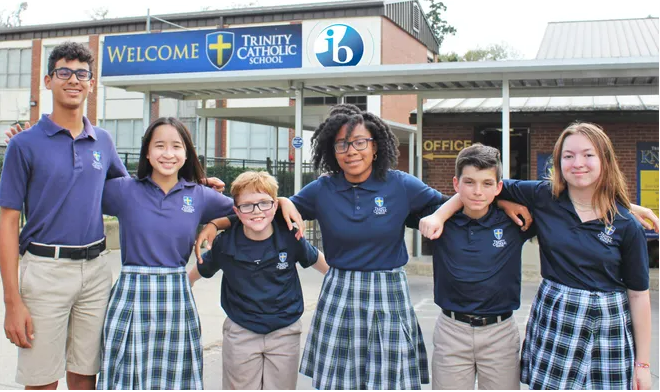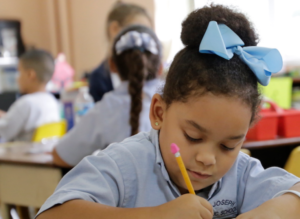
As Catholic school enrollment grows, many schools, such as Trinity Catholic School in Tallahassee, Florida, are adding new programs. Trinity announced in March 2022 that it had received authorization as an International Baccalaureate School following an intense, two-year candidacy phase.
Editor’s note: This question-and-answer interview with Lincoln Snyder, president and CEO of the National Catholic Educational Association, appeared Sunday on catholicworldreport.com.
Catholic schools in the United States have grown in enrollment for two straight years, reaching record levels in some dioceses. Nationwide, Catholic enrollment jumped from 1.63 million to 1.69 million students, an increase of more than 3.5%, according to data released in February by the National Catholic Educational Association.
Though the statistics show that enrollment has not yet reached pre-pandemic levels — 1.74 million students enrolled in 2019 — the reversal is notable, as before the pandemic enrollment was trending down by 2% to 3% annually.
Lincoln Snyder, president and CEO of the NCEA, which works with Catholic educators to support ongoing faith formation and the teaching mission of the Catholic Church, spoke with CNA about the new numbers and the state of U.S. Catholic education today.
Can you break down for me how the enrollment numbers at Catholic schools (in the U.S. overall) have changed since the start of the pandemic?
We did see an initial drop in those first months of the pandemic. There was a lot of disruption for a lot of families in a lot of places. And so, the following May of 2020, we did see a drop in enrollment. We saw a number of schools close. A lot of difficult decisions were made at that point, but since then, Catholic schools have been on a consistent two-year upswing, so it’s very encouraging news for us.
We saw a 3.8% gain overall in the 2021-22 school year [an increase of 62,126 students]. And now in the 2022-23 school year, we’ve seen it go up another three-tenths of a percent [an increase of 5,076]. So just by way of numbers, our biggest single archdiocese in terms of enrollment is Los Angeles, and we’ve added more than another L.A. to our overall Catholic school enrollment. So for Catholic schools, this has been a really significant gain just in terms of the number of kids in our schools.
Do you know how many of the Catholic and public school families who moved to home schooling at the start of the pandemic have remained in that arrangement?
It’s very hard for us to track exactly what happened to individual families. And part of the reason I say that is we’ve also seen a lot of movement of people within the United States, and within regions. So the gains have been stronger in the South, Southeast, and Southwest. Obviously, in the Northeast, we’ve seen some places lose overall numbers of kids in big numbers. Home school is definitely one of those places where a lot of families ended up — we know that as a national trend.
I really couldn’t say with any confidence how many kids that had been at Catholic schools pre-pandemic would have ended up in home schools today. We just don’t have data. But I will say that we have more new families in our schools now than we did. So people have either changed schools within their area, or they’ve moved to a new area in really big numbers. And we know that in both those cases, it appears that families were much more likely to consider a Catholic education than they have been before.
To continue reading, click here.

Catholic schools in Florida, such as St. Joseph Catholic School in Tampa, contributed to an overall 6.3% enrollment increase in 2021-22, the biggest jump of any of the 10 states with the biggest Catholic school enrollments.
Editor’s note: This article appeared Tuesday in the Clarion Herald, the official newspaper of the Catholic Archdiocese of New Orleans.
A panel of four Catholic education leaders touted the resiliency and flexibility of Catholic schools in the United States during and after COVID at the National Catholic Educational Association Convention (NCEA) April 21 in New Orleans.
“We have a great story to tell right now,” said Lincoln Snyder, president and CEO of the NCEA, mentioning how well Catholic schools performed during the pandemic and the increase in enrollment from 1.62 to 1.69 million students – the first gain in 24 years.
“Harnessing the power of that storytelling is going to be a great opportunity for us going forward,” Snyder said. “We are very different from other school systems.”
Moderating the panel, “The State of Catholic Education,” Jill Annable, senior vice president of programs for the NCEA, asked four pertinent questions about the state of Catholic education today.
New families came to Catholic schools because they wanted in-person learning, but stayed because they have fallen in love with the community and saw how well-served their children were by Catholic education, Snyder said. Federal scholarship programs also benefited families who maybe couldn’t afford tuition before.
To continue reading, click here.
 Faith-based schools will be more effective in expanding school choice – and in getting Americans to see their value - if they work together across traditional lines, suggests the chairman of a new national commission that aims to foster that kind of coalition.
Faith-based schools will be more effective in expanding school choice – and in getting Americans to see their value - if they work together across traditional lines, suggests the chairman of a new national commission that aims to foster that kind of coalition.
“We want to encourage the leaders of faith-based schools to become more engaged, to make sure that together, across lines, across sectarian and religious lines, they join forces to advocate for the families and for their institutions,” said Michael Guerra, who chairs the Commission on Faith-based Schools, in the podcast below.
The 14-member commission, which met for the first time last month, was launched by the American Center for School Choice. Guerra is a founding director of the center (which co-hosts redefinED) and past president of the National Catholic Educational Association.
It’s no coincidence the commission is emerging now, he said. Publicly funded school choice is rising in acceptance and yet, at the same time, there is enormous flux among faith-based schools. Catholic schools, for example, have been dwindling in urban areas where they long anchored neighborhoods and served low-income families. “These are assets too precious to be lost,” Guerra said. (more…)
The American Center for School Choice, which partners with Step Up For Students to host redefinED, has just established a Commission on Faith-based Schools. Here is the press release announcing its formation.
An ecumenical commission of leaders representing the majority of faiths that operate schools in the U.S. plans to collaborate and inject the importance of full parental choice in education into the national dialogue, the American Center for School Choice announced today. The Center’s newly-established Commission on Faith-based Schools met for the first time last Thursday in New York City.
“It is essential that the right and freedom of parents to choose the best education for their children be recognized and we believe this Commission will make an important contribution toward that goal,” stated Peter Hanley, executive director of the Center.
The Commission’s two immediate tasks will be to: 1) expand public understanding and appreciation of the role of faith-based schools in American education, especially in low-income communities; and, 2) address the need for expanding publicly funded school choice to increase a family’s ability to choose from among a full range of options, including a faith-based school. Over the coming months the Commission will be documenting the characteristics and benefits these schools provide to families and to American education. It will be releasing a report and convening a national conference in spring 2013 to communicate its findings.
“Faith-based schools have served families well since America's earliest years. In recent years, many religious communities have opened new schools, and today faith-based schools are more diverse than ever. Unfortunately, many more have closed, especially in urban areas where they have been a powerful source of hope for many families. Faith based schools are precious assets, not only for the families they serve, but for the nation. Families have a right to choose faith based schools, and a wise nation should support their choice" commented Commission Chairman Michael Guerra, an American Center board member and former president of the National Catholic Educational Association. (more…)
Our perceptions of inadequacy of public schools has led politically to our infatuation with standardized testing, and that has upended the mission to educate the whole child, writes Philip V. Robey, an executive with the National Catholic Educational Association and a former principal and teacher in public schools and Catholic schools.
In his Education Week commentary, Robey says the larger field of education could learn some things from the administration of Catholic schools:
When Catholic schools say they teach the whole child, they mean it. By nature and mission, these schools operate in such a way that moral choices and character values are just as strongly emphasized as educational performance. This emphasis contributes to a culture fostering the notion that it is important to use our gifts well, and be appreciative of them ...
... In high-stakes testing environments, the educational emphasis falls on adults and their ability to raise students’ scores. The stakes are important enough that financial incentives are sometimes used as enticements. While, on the surface, this sort of rewarding may seem harmless, it can undermine the educational process by putting such a heavy emphasis on test scores that there is little energy for much else.
Statements like that would find a friendly audience in Diane Ravitch, Matt Damon and the masses behind Save Our Schools. So why do these same advocates become unraveled at the prospect of publicly funding a scholarship that could bring a low-income child to one of Robey's schools?